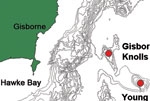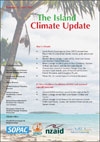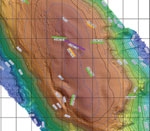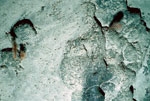PDF of this article (232 KB)

Sampling the depths: seamount life over 2 km down




In November last year, scientists on RV Tangaroa deployed sampling and photographic equipment on two seamounts off Hawke Bay at depths up to 2950 m. This is the deepest that samples have been taken from seamounts in the New Zealand region, and the exercise provided a number of new and fascinating animals.
The voyage was part of NIWA’s ongoing seamounts research programme, which is describing the biodiversity of seamount features around New Zealand and determining the factors that affect what animals live in the varied habitats that these features provide. A recent statistical analysis of the physical characteristics of seamounts (factors such as depth at the summit, elevation above the seafloor, overlying surface water mass, geological origin and association) revealed a distinct grouping of deep seamounts on the Hikurangi Plateau, off the east coast of the North Island. However, there had been almost no biological sampling on these features, and so we were interested in obtaining information about the fauna in order to see if it was distinct from that of seamounts in other parts of New Zealand, as might be predicted from the previous analysis.
We sampled on Gisborne Knolls and Young Nicks Seamount using an epibenthic sled (a collection device that is towed across the seafloor) and beam trawls (a small net). We dropped cameras to the seafloor along three transects to get images of the bottom to document how animals are distributed naturally – information that’s lost once they've been jumbled up in the sled and trawls. The depths sampled ranged from 2100 to 2950 m.
The seabed was quite different at the two seamounts. Gisborne Knolls had hard bottom – the sled often came up containing large chunks of basalt pillow lava – while Young Nicks was less rough, with a layer of soft sediment over much of the seamount. The bathymetry (or water depth contours) of these seamounts was not well known, and so we used swath-mapping, to produce very detailed bathymetry and topography.
Samples of animals were generally small, but included a variety of invertebrate species. We recovered a lot of starfish, sea squirts, sea cucumbers, brittle stars, and polychaete worms. Few fish were caught. Brittle stars were abundant in the beam trawls from Young Nicks Seamount, and generally the invertebrate abundance was greater there than on Gisborne Knolls.
Taxonomists at NIWA, and at other institutes in New Zealand and overseas, are still identifying the animals we sampled. We collected several echinoderms that could not be identified by experts onboard, and they are likely to be new records for New Zealand. Other interesting finds included an isopod, a galatheid shrimp, and some small barnacles, all of which are probably new species, or at least new records for New Zealand waters. At this stage, findings are supporting the expectation that this deep fauna is indeed different from other seamounts around New Zealand.
For further information, contact: Dr Malcolm Clark, 0-4-386 0523, [email protected] Dr Ashley Rowden, 0-4-386 0394, [email protected]
